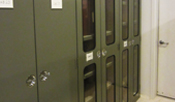CULTURAL PROPERTY PROTECTION
PROTECTION OF COLLECTIONS

LCI provides best practices consulting assistance for the protection of all types of collections, on exhibit, in storage, and in transit.
Consider the below recommendations for your operation, and contact us if we can assist with your protection planning and implementation…

Protection technologies and philosophies are subject to change in the protection of cultural, public, and educational institutions, as they are in other areas of security planning. Experts agree that there are very basic requirements for the enhancement of life safety, as well as the protection of valuable collections and other assets. These requirements have evolved somewhat over the years, as technology advances. Administrators and others have been reluctant to initiate change, primarily based on the common excuse, “those types of threats will never happen here.” “Never” has come sooner than expected for many. These solutions are not absolute. They are however, sound prevention steps that will be helpful in most environments. Applications vary with the size and type of institution.
Click on the steps below to see detailed descriptions.
From the instant that visitors enter your facility, the image projected by all staff, uniformed security officers, electronic equipment, and even the cleanliness of the facility, lead visitors to form an opinion about the institution’s level of preparedness. Make sure that the image your facility projects is one of an alert, capable, and responsive organization.
By exceptional, we refer to the protection of the rooms or enclosures in which collections are located, as well as the buildings where collection rooms are located and the main approaches to these rooms. Access to any collection storage area should be controlled by sophisticated electronic means, to include access controls, intrusion alarms, and video surveillance equipment. These measures are not practical in every application, especially where funding is limited. Reasonable perimeter protection would mean the use of solid core or metal doors, barred or reinforced windows, detection devices on all accesses, area motion detection in entryways and throughout storage areas, and consideration of alarm activated video surveillance.
Include every element of physical, procedural, and electronic protection. Require all elements and departments within your organization to contribute to this plan. The written plan is no more than an operational guideline. It serves as a reference point for the initiation of protocols and training exercises, and in an actual emergency, may be used as a point of reference. The plan should include notification designations for most incident contingencies, including public utilities, contract security services, transportation services, public relations/media services, offsite collections storage, recovery services, and other necessary assistance. You should, as a part of your plan, consider the complete evacuation of the facility, safe movement of designated collections to a secure, temporary facility, and arrangements for counseling services for disaster victims and survivors.
Listen to those staff members and others who are most familiar with daily operations. This includes all staff, students, visitors, volunteers, vendors, and friends or relatives. In almost every incident where loss or other incidents have occurred, employees and others interviewed have said, “everyone knew about that problem”. “Why didn’t someone do something about it before it happened?” The reason is that although many workers are aware of a budding problem, few actually report the problem. Unfortunately, many reports, when received, are ignored. The most effective form of communication is an anonymous reporting system. The posting and publicizing of a toll free number that can be called by any employee, anytime, that does not identify the caller, has led time and time again to the prevention of serious incidents.
Regardless of how frivolous or ridiculous some reports may seem, every report of a loss, activity or suspicious activity must be followed up by direct and indirect inquiries, documentation, and completion of a reasonable investigation. Notification of the report to the facility’s senior management should be a regular process. There is no excuse for a director, administrator, or senior manger to say, “no one told me” about a suspected problem.
One person cannot be expected to visualize every potential problem in a facility’s collection protection program. This is especially true if that person works in the facility every day and has limited prospective. There are several alternatives for receiving an objective evaluation. The community services divisions of most law enforcement agencies offer no-cost evaluations. You can also ask persons in similar positions from other institutions to perform an evaluation on an exchange basis. Consultants who specialize in the protection of cultural institutions are also available to perform this service.
Alarm systems, access systems, fire detection systems, video surveillance systems, and emergency communications systems are like any other electronic devices. At one time or another, electronics suffer failures. Many institutions, frustrated by “false alarms”, disconnect portions of electronic systems or ignore signals indicating system trouble. It is rare to find a system beyond two or three years in age where some portion of the system is not fully operational. Most often, administrators or managers are not aware of these problems. Whether by independent contract, agreement with the installing company, or by internal measures, you need to establish a complete and regular testing schedule of every device, on every system. Each test must be documented.
Whether local, regional, or national in scope, other organizations and institutions are often an excellent source of intelligence information regarding threats to collections, area crime information, and available prevention measures. At least one member of management staff should maintain an active involvement with others involved in the protection of cultural properties, and where possible, with local law enforcement intelligence sources.
Involve your entire staff, all volunteers, and every emergency agency that may respond to your facility. In pre-planning meetings, coordinate the duties of employees with the expected response from emergency agencies. The walk-thru of simulated events is the most practical and most effective type of training available. You cannot expect anyone to react in an emergency and protect collections with any proficiency unless they have had the opportunity to practice their assigned duties in a realistic exercise.
Fire
is still the primary threat to collections. Fire protection starts with a viable prevention program. In addition to the emphasis we placed on patrols and electronic systems in all publications, the institution needs to think about those daily violations of documented fire codes, as well as common sense fire prevention tools.
Other primary threats
to valuable collections include natural disasters, theft, terrorism and both unintentional and intentional damage. All of these eventualities need to be addressed in your emergency operations plan.
Theft prevention
doesn’t happen by accident. As verified in numerous surveys, internal theft, or internally related theft is responsible for over 90% of losses from valuable collections. That means that anyone, from Trustees, to Directors, to Security Managers…Curators…anyone…may be involved in theft. The rules must apply to everyone. Background screening must be consistent and professional. Pre-employment screening should be mandated. Post employment criminal history checks may also be helpful. Just because someone has worked for the institution for years doesn’t mean that haven’t run afoul of the law outside of the job. You have a right, if not a definite need to know.
Protection of collections begins at the outermost perimeter. A combination of security patrols, police patrols, enhanced lighting, intrusion detection, video surveillance, package inspection, and supervised egress points are all necessary.
Utilize reasonable rules of conduct
to protect collections from intentional and unintentional damage. These rules must be published, and available for viewing by patrons, and/or posted in a conspicuous manner
Protection of collections is EVERYBODY’S business!
This includes administrators, collections managers, maintenance workers, food service workers, vendors, and volunteers. Advise each category of employee and volunteer about your expectations for being observant and reporting suspicious activity.
- Collections On Exhibit
- Collections in Transit
- Collections in Storage Rooms
We are concerned about vulnerabilities to valuable collections while in transit, in storage, and during construction. Collections on exhibit have the most exposure to the public, are often unprotected electronically, and afford an excellent opportunity for losses from vandalism, deliberate destruction, and on occasion, theft.
While armed or strong-arm robbery has been rarely seen in the U.S., it has occurred, and appears to be on the rise in Europe. Collections on exhibit may be subject to “smash and grab” types of theft, switching with fakes or counterfeit productions, or malicious destruction by persons with open access.
To protect from losses, the institution may utilize these commonly applied measures:
- Active Patrols
- Video Surveillance
- Electronic Detection
- Barriers
- Signage
The best method of protecting exhibits is to begin at the outermost perimeter and apply reasonable protection measures that allow the institution to control entry, monitor activity, and quickly respond to potential threats. The patrol is a vital aspect of the protection package. Many institutions cannot afford to utilize uniformed security. In these circumstances, every member of the staff and every volunteer need to be actively involved in patrolling exhibits.
The best deterrent to theft and vandalism is an alert staff, with every member tasked with daily observation, close attention to suspicious persons and/or activities, and an open communications system. There is no universal “standard” for exhibit protection. Because every institution has its own unique operating environment, the best protection plan may vary with available levels of staff, video monitoring, electronic barriers, and physical barriers.
A practical plan for protecting exhibits begins with a proper analysis of all supporting factors, such as:
- Access points in and out of exhibit areas
- Ability to monitor and respond to alarms
- Prioritizing exhibits requiring special protection
- Cost of purchasing, servicing, and maintaining electronic exhibit protection
- Daily visitor numbers and pedestrian traffic patterns
- Concerns of collection management, curatorial, facilities, and security staff
Keep in mind that the majority of art theft involves someone on the staff, formerly on the staff, related in some manner to someone on the staff, or someone with direct knowledge of operations from past or present access. That means that any systems or other measures utilized should be equally effective for persons within the organization who may have unrestricted access during normal operating hours.
In evaluating the vulnerability of your collections, consider the following questions: Can anyone remove an exhibit from a case or the wall with little restriction or detection? How often are exhibits actually observed by a staff member who is familiar with each item on exhibit? Are exit routes from exhibit areas protected? Are delayed egress doors in place? Are audible alarms active? Is there guaranteed response to alarms within a reasonable time? How long would it take to grab an object run out an exit, and be outside the building? Does video surveillance cover most of the exhibit area, and/or exit routes?
Valuable collections of any type, size, or value are especially vulnerable when in transit, outside of collection storage, or away from protected exhibit spaces. The arrangements for shipping valuable collections is normally relegated to curatorial staff, registrars, or in some cases, directors.
While 99 times out of 100 there are no problems encountered, and no losses or damage experienced, it’s that one time that makes the difference. “We’ve never had that kind of problem before” is not a valid excuse for leaving out professional protection planning. Where professional security management is available, they should be directly involved in the planning process. If no such assistance is immediately available, consideration should be given to the contracting of professional advice from recognized industry experts.
The Plan. The safety and security of collections in transit is at risk from the time they are removed from the security of collection storage, until the time they are placed in a secure storage area at the point of arrival. Before any collection item is removed from storage or exhibit space, a document authorizing its removal, signed by the person known to be in charge of the object, should be presented to the present custodian of its care. Persons who may be in temporary custody of the collection item should be identified, and proof of completion of reasonable background checks provided to the owner. This should include drivers, escorts, other employees involved with the transfer of the artifact, and principals of the transport company.
Collections should be protected in suitable containers, secured with a high security lock. Persons selected for escort duty or additional protection should undergo reasonable background checks.
The entire route of transit should be checked for areas of vulnerability to attack. It may be advisable to discuss route plans and travel times with local police. Route security is a meticulously planned process that should be undertaken by professionals. Do not assume that transport companies, contract guard services, or in-house security details have any experience in this process.
Briefings should be conducted for each element of the transport team, to include drivers, escorts, dispatchers, law enforcement, contract security, in-house security, and collections management staff.
Just as museums are required to complete facilities security reports for borrowed or on-loan exhibits, similar reports are necessary to assure that the receiving end of art shipments is properly secured. The responsibility of the shipment team is not over until the shipment is safely stored at the receiving end and signed for by authorized receiving parties.
The protection of collection storage rooms, or those rooms where accessioned art work, rare books, or "on loan" artwork is stored shall be secured in a special manner that affords a higher level of protection from both internal and external threats. These rooms are commonly referred to as "vaults," and should be protected as such.
A detailed list of recommended features is found in "Suggested Practices for Museum Security, " Section 14 (revised 2002).
The following guidelines should serve as a summary of methods and procedures for consideration by this institution:
- Walls shall be floor to the slab above, with no penetrations. Walls shall be of such construction as to deter entry by breaking through drywall or other surfaces.
- Entry doors shall be of metal or solid core wooden construction.
- Window glass should be avoided in any room where collection materials are stored. Where present, glass should be bullet resistant, and frames protected from removal by mechanical means or by force.
- The collection storage area shall restrict access by any other than specifically authorized persons. The desired means of control is by electronic access controlled doors. Where the use of electronic locks is not practical, mechanical locking systems utilizing hardened steel locking cores, and restricted key issue is recommended.
- A manual sign-in sheet should be utilized where electronic locks reporting to a computerized database are not available.
- Access controlled doors may be activated/opened by use of electronic card readers, combination touchpad/card readers, biometric scanning devices, or other electronic means which scrutinize users to determine proper levels of authority.
- Any doors accessing collection storage shall be protected by concealed magnetic door sensors, or high security (bias) type door sensors.
- Seismic sensors may be considered where wall or ceiling penetration is possible.
- Dual technology or better motion sensors should be within the collection storage area to deny the possibility of "stay behinds," and to detect movement of any kind when the room is secured.
- Video surveillance cameras should be placed to observe activity at the room's entry(s), and within the room itself to observe as much activity as possible.












